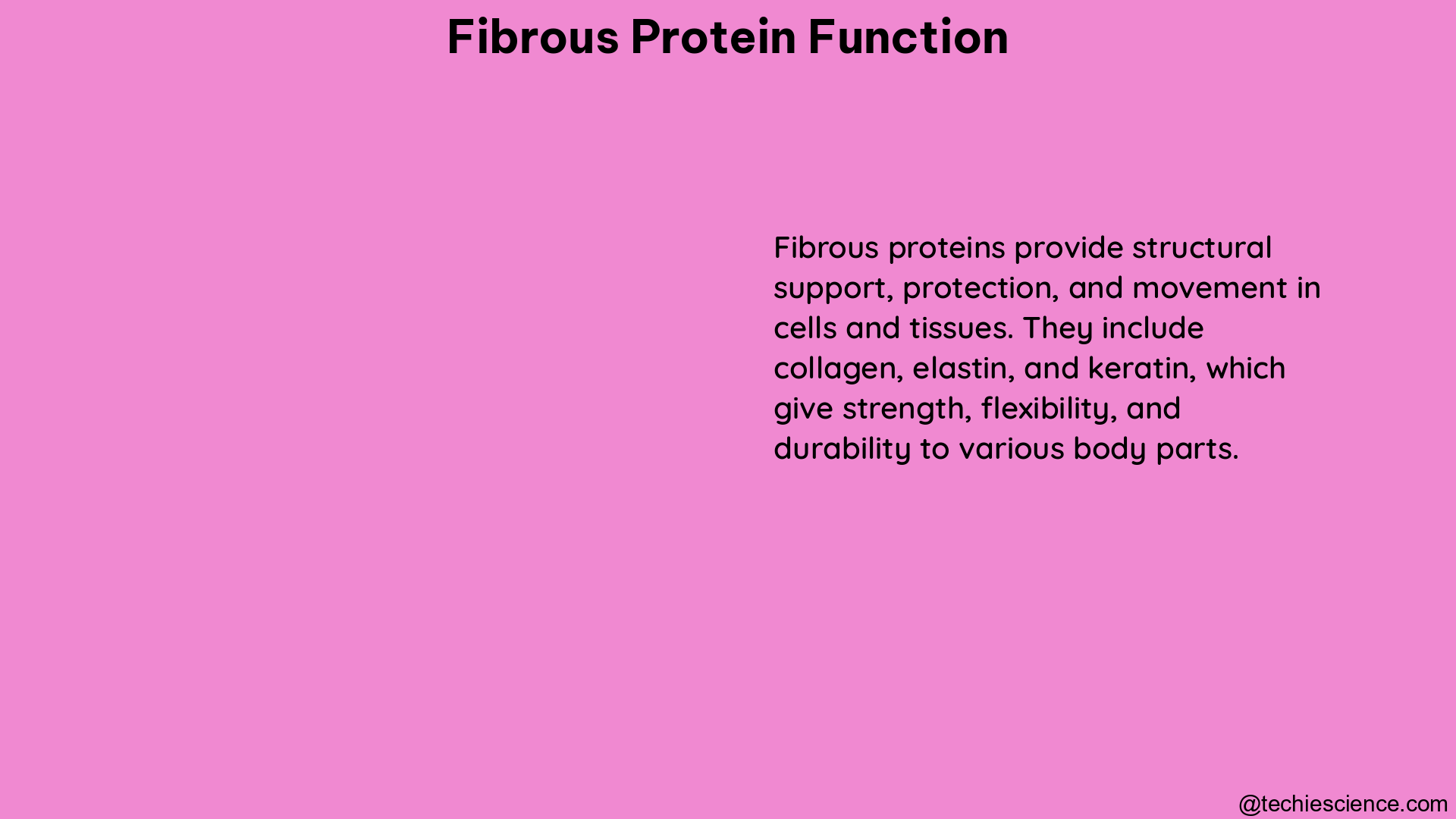Fibrous proteins are a class of proteins that possess a long, thin, and fibrous structure, providing strength, support, and elasticity to various tissues in the body. These remarkable biomolecules are characterized by their ability to form stable, insoluble structures, enabling them to perform their essential functions effectively. In this comprehensive guide, we will delve into the intricate details of fibrous protein function, exploring their unique properties and the crucial roles they play in maintaining the integrity and resilience of our biological systems.
Tensile Strength: The Backbone of Structural Integrity
Fibrous proteins are renowned for their exceptional tensile strength, which allows them to withstand significant mechanical stress. Collagen, a major fibrous protein found in the body, boasts a tensile strength of approximately 60-100 MPa, surpassing even the strength of steel. This remarkable property is attributed to the unique triple-helix structure of collagen, where three polypeptide chains twist around each other, forming a robust and stable configuration. The high tensile strength of fibrous proteins is crucial in providing structural support to tissues, such as skin, tendons, and ligaments, ensuring their ability to resist deformation and maintain their integrity under various physical stresses.
Elasticity: The Adaptive Advantage

In addition to their impressive tensile strength, fibrous proteins also exhibit exceptional elasticity, enabling tissues to stretch and return to their original shape. Elastin, another key fibrous protein, can stretch up to 150% of its original length and still recoil back to its initial form. This remarkable elasticity is achieved through the unique random coil structure of elastin, which allows the protein to unfold and refold without permanent deformation. This property is essential in tissues that require a high degree of flexibility and resilience, such as the skin, blood vessels, and the lungs, allowing them to adapt to various physical stresses and maintain their functional integrity.
Cross-linking: The Reinforcement Strategy
Fibrous proteins further enhance their stability and resistance to degradation through the formation of cross-links between their molecules. Collagen, for instance, forms covalent cross-links between its individual molecules, significantly increasing its tensile strength and overall structural integrity. This cross-linking process is facilitated by specialized enzymes, such as lysyl oxidase, which catalyze the formation of these critical bonds. The degree of cross-linking in fibrous proteins can vary depending on factors like age, tissue type, and physiological conditions, directly impacting the mechanical properties and functional capabilities of the associated tissues.
Higher-order Structures: The Architectural Masterpieces
Fibrous proteins adopt diverse higher-order structures (HOS) to enable their unique biological functions. Collagen, as mentioned earlier, forms a characteristic triple-helix structure, where three polypeptide chains twist around each other to create a robust and stable configuration. In contrast, elastin adopts a random coil structure, which allows for its exceptional elasticity. These higher-order structures are the result of complex folding patterns and interactions between the individual amino acid residues within the fibrous protein molecules. Understanding the relationship between the HOS and the specific functions of fibrous proteins is crucial in unraveling the intricate mechanisms underlying their roles in various physiological processes.
Biosynthesis: The Intricate Manufacturing Process
Fibrous proteins are synthesized in the body through a complex biosynthetic pathway that involves several post-translational modifications. Collagen, for instance, is initially produced as procollagen, a precursor molecule that undergoes a series of enzymatic cleavages to form the mature collagen protein. This multistep process ensures the proper folding, assembly, and cross-linking of the collagen molecules, ultimately contributing to the formation of the robust and functional collagen fibrils observed in various tissues. The regulation and coordination of these biosynthetic pathways are crucial in maintaining the appropriate levels and distributions of fibrous proteins, which are essential for the proper functioning of the body’s structural and mechanical systems.
Mutations: The Genetic Vulnerabilities
Mutations in the genes encoding fibrous proteins can lead to various genetic disorders, highlighting the critical importance of these biomolecules in maintaining the integrity and function of our tissues. For example, mutations in the collagen genes can result in conditions like Ehlers-Danlos syndrome and osteogenesis imperfecta, characterized by abnormalities in the structure and mechanical properties of collagen. Similarly, mutations in the elastin gene can contribute to the development of Marfan syndrome, a disorder associated with cardiovascular and skeletal complications. Understanding the genetic basis of these fibrous protein-related disorders is crucial for developing targeted diagnostic and therapeutic strategies to address these debilitating conditions.
In conclusion, fibrous proteins are remarkable biomolecules that play a pivotal role in maintaining the structural integrity, elasticity, and resilience of various tissues throughout the body. Their unique properties, including high tensile strength, elasticity, cross-linking, and diverse higher-order structures, are essential for the proper functioning of our biological systems. By delving into the intricate details of fibrous protein function, we can gain a deeper appreciation for the remarkable adaptations and evolutionary strategies that have enabled these proteins to become indispensable components of our complex and dynamic physiology.
References:
- Wang, X., Kim, H. J., Wong, C., Vepari, C., Matsumoto, A., & Kaplan, D. L. (2006). Fibrous proteins and tissue engineering. Materials Today, 9(12), 44-53.
- Fibrous protein & Globular protein | PDF – SlideShare. (2019). Retrieved from https://www.slideshare.net/SaraKhan1/fibrous-protein-globular-protein
- The properties and functions of fibrous proteins. Flashcards – Quizlet. (n.d.). Retrieved from https://quizlet.com/gb/495524524/the-properties-and-functions-of-fibrous-proteins-flash-cards/
- Mass Spectrometry-Based Protein Footprinting for High Order Structure Analysis. (2021). Retrieved from https://www.biorxiv.org/content/10.1101/2021.03.15.435443v1.full
- The differences between fibrous proteins and amyloid fibrils. ResearchGate. (2022). Retrieved from https://www.researchgate.net/publication/359524524_The_differences_between_fibrous_proteins_and_amyloid_fibrils
Hi..I am Tanu Rapria, I have completed my Master’s in Biotechnology. I always like to explore new areas in the field of Biotechnology.
Apart from this, I like to read, travel and photography.